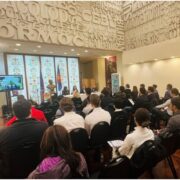
The Department of Tourism (DOT) welcomes the forthcoming implementation of the electronic visa (e-visa) system for temporary visitors with its pilot implementation among Chinese nationals, to be followed by Indian nationals by yearend, as announced by the Philippine Department of Foreign Affairs (DFA).
During the visa reforms convergence meeting organized by the DOT last March 24, 2023 corresponding to the directive of President Ferdinand R. Marcos, Jr., the DOT, DFA, Department of Information and Communications Technology (DICT), Department of Justice (DOJ), and the Bureau of Immigration (BI) had discussed the streamlining of the visa application process, aiming to enhance convenience and accessibility for all international travelers, starting with Chinese visitors.
“We are grateful that the directive of President Ferdinand R. Marcos, Jr. to implement the e-visa system will soon come into fruition with DFA’s implementation as it will surely improve the experience of inbound travelers and tourists, and have a positive impact on our international arrivals especially in the Chinese and Indian markets. We believe that this will also foster even closer people-to-people exchanges, cultural understanding, and vibrant tourism cooperation,” Tourism Secretary Christina Garcia Frasco said.
In 2019, more than the 1.7 million Chinese visitors to the Philippines were recorded by the DOT. As of July 26, 2023 the agency tallied 137,822 arrivals from China, following the recent lifting of travel restrictions for the Chinese.
The e-visa is also considered as one of the windows that could raise the confidence of airlines, charter operators, and travel agents to resume flights from various points in China directly to tourist destinations in the Philippines such as Boracay, Bohol, Cebu, Legaspi, Clark, Laoag, Lallo, and Manila due to the projected ease and increase in visa processing.

“Certainly, the e-visa will be a game changer in the Chinese market, which currently prefers other Southeast Asian destinations such as Thailand, Indonesia, Vietnam, Malaysia, and Cambodia which provide landing visa to Chinese travelers thus gaining faster momentum for the tourism recovery of these countries from the negative impacts of the pandemic,” noted Secretary Frasco.
“One of the foremost advantages of this initiative is the positive impact it can have on revitalizing the Philippine tourism industry. Prior to the pandemic, China stood as the Philippines’ second top tourist market, contributing significantly to our nation’s vibrant tourism landscape with a record 1.7 million visitors in 2019. The e-visa system’s introduction holds the promise of recovering the Chinese market and opening up to the Indian market,” she added.
The visa reform convergence meeting was convened primarily to help simplify the visa application procedures of the Philippines given the intention of the DOT to help accelerate the tourism resurgence in the country, with the borders of different countries gradually being opened as the lockdown effect of the pandemic wanes globally. It also meant to address the tourism bottlenecks brought about by bureaucratic and procedural hurdles.

Earlier this year, no less than President Marcos, Jr. directed the concerned government agencies to extend the e-visa to certain nationalities to encourage tourists from their countries to visit the Philippines.
“The Philippines takes great pride in its diverse and captivating tourist destinations, rich cultural heritage, and warm hospitality. We are confident that the implementation of the e-visa system will encourage more Chinese and new Indian visitors to explore the wonders of our archipelago, creating unforgettable experiences and lasting memories that will certainly make them Love the Philippines as a top-of-the-mind tourist destination,” enthused Secretary Frasco.






